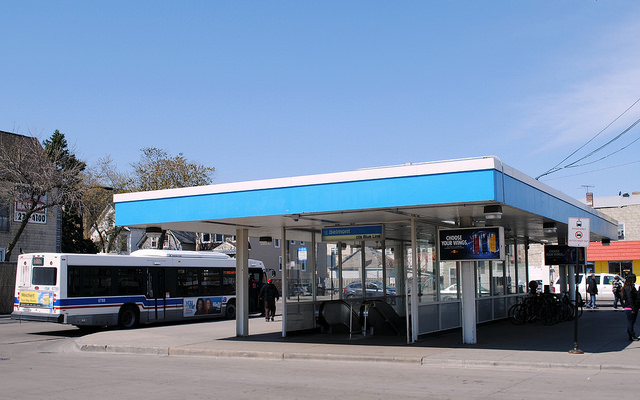
The Chicago Transit Authority plans to test off-board fare collection – where riders pay on the sidewalk before boarding the bus – in an unexpected location. Previously, the CTA and the Chicago Department of Transportation announced they would pilot prepaid fare collection at the Dearborn/Madison station on Loop Link. Instead, the first off-board fare collection will be tested in Avondale on the northwest side.
Flyers posted yesterday at the Belmont Blue Line station, on buses, and shared on Twitter, told riders that the Chicago Transit Authority is going to test a new boarding procedure for the westbound 77 Belmont bus at the station.
Starting Monday, June 6, riders heading west during the 3 p.m. to 7 p.m. rush hour from the subway station will pay and enter a "paid area" before waiting and boarding the next bus. The CTA will set up a mobile fare collector at the entrance to a designated and sheltered "paid area."
In other U.S. cities with off-board fare collection for buses, there is no "paid waiting area." To ride a Select Bus Service route in New York City, riders exchange their fare for a receipt at a special vending machine. If a fare inspector comes, you must show the receipt.
Muni, the bus and light rail operator in San Francisco, implemented all-door boarding in 2012, which requires those who enter the rear door to tap a Ventra-like card at a card reader in the back of the bus, or have a valid pass. Fare inspectors may ask you to show the pass, a transfer receipt, or check your card to see that you checked in to the bus.
The pilot will last for six months. The CTA said in a statement that "prepaid boarding is expected to provide customers with faster boarding and reduce bus delays that occur from the high volume of customers."
Many outbound Blue Line riders who get off at the Belmont station transfer to the Belmont bus, and after each train stops, a crowd of people walk up to the westbound or eastbound waiting areas at the same time and form long queues.
CTA's press release also said "current boarding times during evening peak periods can take as long as 5 minutes due to heavy ridership" and since buses come every four to five minutes during rush hour, the slow boarding process sometimes results in bus bunching and trip delays.
CTA will install a new vending machine on the sidewalk so riders can add value or passes to their Ventra cards, or buy a new Ventra card. People who would have paid with cash onboard the bus can ask a CTA customer assistant for a special paper ticket. Spokeswoman Tammy Chase said riders can take the paper ticket to the vending machine, load $2 onto it, and reload it at any 'L' station.
Normally, paying cash at a vending machine costs $3, which prints a chip-enabled paper Ventra ticket that has enough fare for a bus ride and two transfers, or a train ride and one transfer, as well as a 50 cents fee. This fee-free ticket, Chase said, ensures that cash-paying customers are also able to take part in the pilot.
This is a good start, but the CTA should increase the sample size for testing. Testing on Loop Link, where multiple bus routes converge onto dedicated bus lanes, should have begun soon after the stations opened in December. CDOT spokesman Mike Claffey said that they are "continuing to work closely with CTA to implement a prepaid boarding pilot on Loop Link this year."
Updated to add comparison to NYC and SF, and why CTA will give cash-paying customers a fee-free Ventra ticket.




